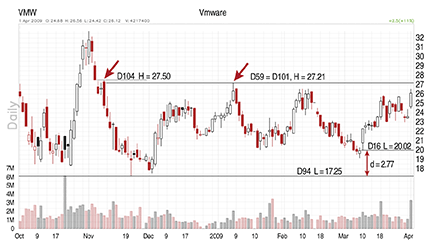CHARTING
The Chartmill Channel
Adaptive And Optimized Channels
by Dirk Vandycke
Chart channels are core instruments that belong in the toolbox of any technical analyst. As useful as they are, they tend to be subjective in nature, which makes them hard to implement algorithmically. Here’s how to optimize horizontal channels, calculate the most optimal ones, and as such, create setups based on their support and resistance characteristics.
Ranges are important when it comes to the automated analysis of charts. They capture price movements between parallel support and resistance lines, enabling us to monitor trends so we know when they are accelerating and when they are slowing. Horizontal channels are useful in detecting consolidating ranges, which indicate if prior existing trends are catching on or turning around or if new ones are emerging. Many popular systems like William O’Neil’s CANSLIM approach, Stan Weinstein’s stage analysis, the box system of Nicolas Darvas, and most trend-following strategies depend on horizontal channels to assess when a new trend, phase, box, or stage is starting.
Of all channels, horizontals are the easiest to define, given that most of what we need to identify them are two price levels. However, what those price levels are is subjective. Trader Richard Donchian provided us with the oldest, perhaps most popular but definitely the most useful ways to define horizontal channels.
Donchian channels
These channels are also known as x-bar high/low. Simply, they are an implementation of the maximum (max) and minimum (min) functions we often come across in mathematics. These functions are derived by looking back over a certain period and calculating the lowest low and the highest high. These then form support and resistance levels. Figure 1 displays a chart of VMware, Inc. (VMW), with one upper Donchian channel line (resistance) with a lookback period of 59 days and a lower channel line (support) with a window of 16 days. Starting from the right side of the chart and going back, the highest high over the previous 59 days was $27.21, while the lowest low over the previous 16 days was $20.02. These lines are labeled as D59 and D16 on the chart in Figure 1

FIGURE 1: DONCHIAN CHANNELS. Donchian channels are amid the oldest and most basic channels in technical analysis, but they are not completely objectively defined. In this chart of VMWare, you can see one upper Donchian channel line with a lookback period of 59 days (D59) and a lower channel line with a window of 16 days (D16).
Excerpted from an article originally published in the July
2012 issue of Technical Analysis of Stocks & Commodities magazine. All rights reserved. © Copyright 2012, Technical Analysis, Inc.
Return to Contents
